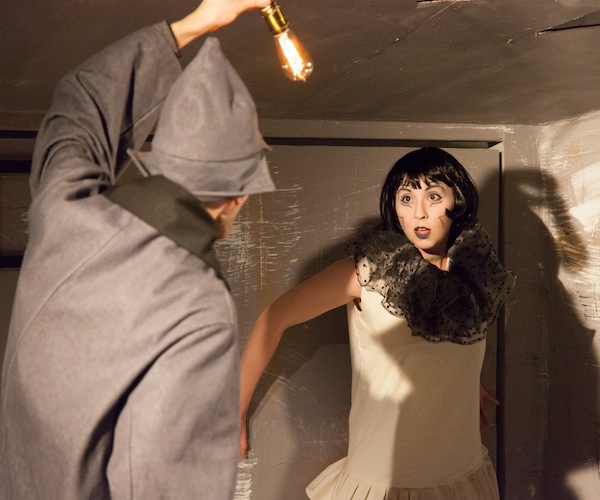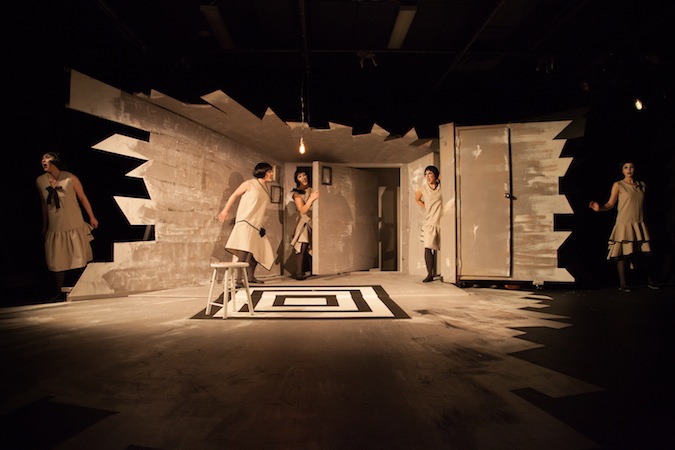Theater Review: Wham “(Betty) Bam” Thank You Mam
Had Daniil Kharms’ texts been available at the high tide of the Theater of the Absurd, his plays would be performed alongside those of Samuel Beckett and Eugene Ionesco.
Betty Bam!: The Daniil Kharms Project Two by Daniil Kharms. Translated from the Russian by Zoya Derman. Directed by Matthew Woods, Joey C. Pelletier, and Michael Underhill. Adapted (based on Kharms’ Elizaveta Bam) and staged by imaginary beasts in the Plaza Black Box Theatre at the Boston Center for the Arts 539 Tremont Street, Boston, MA, through May 2.

William Schuller and Amy Meyer in the imaginary beasts’ “Betty Bam.” Photo: courtesy of imaginary beasts.
By Bill Marx
The crimes Stalinism committed against artists have been aided and abetted by the brutality of time. Brilliant experimental writers such as Andrey Platonov (1899-1951) and Daniil Kharms (1905-1942) were persecuted, forbidden to publish, and finally silenced. In the case of the luckless Kharms, during the ’20s he was active in an avant-garde group that attracted the attention of the authorities: he was first arrested in the early ’30s, told he could only write for children, and then, when those pieces were deemed subversive by the Soviet police by the end of the decade, tossed into a psychiatric prison where he apparently starved to death. His ‘crime’ was no more and no less than wanting the freedom to break all the rules: “I am interested only in ‘nonsense,'” Kharms wrote in 1937, “only in that which makes no practical sense. I am interested in life only in its absurd manifestations.”
If skillful translations of Kharms’ postmodern sketches and playlets had been available in the ’50s or ’60s, during the high tide of the Theater of the Absurd, I am convinced his minimalist works would be read or performed alongside those of Samuel Beckett and Eugene Ionesco. But Kharms’ texts were pulled out of the Soviet vaults (or the safe-keeping of friends) during the ’60s and by the time they made it into English they looked exotic and/or antiquated. Kharms was perfect for academics to pour over and expound upon — there is much buzz about how he anticipated deconstruction — but it was too late for him to become part of the literary mainstream in the West.
Worse, the imaginary beasts are staging Kharms’ illogical work at a very bad time. American theater is committed to reassuring Hollywood realism, didactic empowerment plays, feel-good formula musicals, and new-circus spectaculars — the very kind of rote entertainment Kharms was dead set against. Making good sense means dollars and cents in today’s market: stagings of Beckett come along now and then, but Ionesco and Genet have just about vanished. Still, the imaginary beasts are determined. First, the company staged a collection of Kharms playlets, stories, and jottings entitled Knock! The Daniil Kharms Project. Now comes Betty Bam!, a second evening of Kharms starring his longest play, 1927’s Elizaveta Bam. It is only about an hour long — most of his other theatrical pieces are what Beckett would call “dramaticules.”
Once you figure out what Kharms is up to, this is a delightfully satiric excursion into genre meltdown. He generates uncertainty by twisting literary conventions to the breaking point and then some. The fun comes from the playwright’s determination never to be pinned down — he serves up absurdity with whiz bang purity. This is a surrealistic ‘murder mystery’ in which both the killer and the solution are up for grabs. The police are after Betty Bam for killing somebody — she isn’t sure who and neither are they. Near the end of the play a murder takes place, but there appears to be no rational link between that death and the paranoid (?) plight of Betty Bam, who is hunted by authority figures. The “drama’ is chopped up into nineteen short scenes (‘bits’), each charged by Kharms to reflect a different genre, from the recognizable (‘Realistic melodrama’ and ‘Realistic Comic drama’) to the bizarre (‘Physiological pathos’). Greek tragedy as well as slapstick farce is mixed in. Each scene’s linguistic registers are scrambled up as well — the lyrical, the mundane, the operatic, and the inane pop in and out of focus. Ideas of guilt and innocence are continually being turned into nonsense and then resurrected. And that kind of exhilaratingly modulated chaos is what Kharms is aiming for – exploding literary genres then moving back to them is a way of making us see that meaning is fluid, continually dynamic.

The bunch of Betties in the imaginary beasts’ production of “Betty Bam!”Photo: courtesy of imaginary beasts.
My problem with the earlier imaginary beasts production was the company’s monochromatic clown approach to Kharms’ writing. The dependence on red noses and baggy pants became wearisome, especially given that this absurdist, like Beckett and Ionesco, is obsessed with dark forces. Kharms translator Neil Cornwell supplies a list: “falling, accidents, chance, sudden death, victimization, and all forms of apparently mindless violence.” Most of this mayhem can be found in Betty Bam! but, though the red noses come out for a bit, most of the time the company tries to be true to the script’s call for a chameleonic adjustment to shifting styles: melodrama, suspense, farce, opera, domestic comedy, puppet show, etc. Kharms demands that the cast morph in and out of different characters quickly — the beasties are generally game, if at times a bit slow.
For some reason the imaginary beasts decided to divide the role of Betty among five actresses (Beth Pearson, Amy Meyer, Molly Kimmerling, Sarah Gazdowicz, and Kiki Samko) who are made up to look like silent film star Louise Brooks. Kharms may have been ecstatic that the play’s confusion was multiplied beyond his initial dreams, but I am not sure it adds all that much, particularly when ‘daddy’ is played by one of the Betties in drag. Cameron Cronin and William Schuller are never all that threatening as the play’s tragicomic police goons and homicidal country folk, but they have their Laurel and Hardy comic timing down. The set, though far less compelling visually than the one constructed for the troupe’s earlier Kharms production, has a stark Futurist beauty to it.
I started out complaining about timing, but my feeling when it comes to Kharms is better late then never. The imaginary beasts are to be congratulated for dedicating themselves to staging the work of an innovative writer whose vision continues to cut against the mainstream grain. In a theater where embracing the predictable has become second-nature, we desperately need this kind of wild and crazy creativity more than ever.
Bill Marx is the Editor-in-Chief of The Arts Fuse. For over three decades, he has written about arts and culture for print, broadcast, and online. He has regularly reviewed theater for National Public Radio Station WBUR and The Boston Globe. He created and edited WBUR Online Arts, a cultural webzine that in 2004 won an Online Journalism Award for Specialty Journalism. In 2007 he created The Arts Fuse, an online magazine dedicated to covering arts and culture in Boston and throughout New England.
